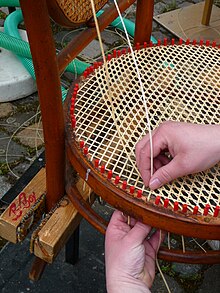rattan

Rattan and wicker are products from the trunk of rattan palms of the genus Calamus or other palms of the subfamily of the Calamoideae .
Origin of name
The term rattan comes from Malay (there: rotan ). Rattan cane comes from the Low German paddik 'plant pulp '. Other names are Manau [s] , Manila , Malacca , named after the respective shipping ports, or "Spanish pipe", "Stuhlrohr", "Rotang". In German usage, "rattan" is often used to denote the outer skin of the shoots or the entire shoot, and "rattan" to refer to the inside of the shoots.
use

The best known uses of rattan and wicker are in wicker and wicker furniture , especially chairs and armchairs . Damp and especially under steam or with a heat gun, the rattan material becomes soft and elastic enough for braiding .
When using it, three different processing options can be distinguished:
- The undivided stems with their smooth, shiny surface are made into walking sticks , carpet beaters , canes and even furniture. Various martial arts (Kombatan, Escrima , Arnis , Bō in Kobudo ) use batons made of sturdy rattan wood, since rattan does not splinter when fighting stick to stick (in contrast to normal wood), but only shreds, which reduces the risk of injury. Rattan is used for various bows , including equestrian bows, longbows, recurves. Since rattan is not very resistant to pressure, reinforcement on the bow belly side (facing) can increase the tensile weight; on the other hand, rattan can serve as a backing (reinforcement of the arch back) for other types of wood.
- The thick parts of the trunk are used for furniture frames.
- The roughly five-meter-long strips with their smooth outer surfaces cut from the surface of the sprouts are used to produce robust wickerwork for pieces of furniture, traditionally mainly wickerwork for chairs. The name for this is "Stuhlwlechtrohr", broader qualities are traded as spiral tubes.
The pipe can be split and the strands obtained can then be drawn to size or planed. The tube is then rolled up and dried. If woven chair cane is to be stained in color, it must be subjected to a special staining, as the outside of the shoot is water-repellent. Woven chair tubing, classified as yellow ribbon , is bleached beforehand. It can also be pickled after processing.
There are several classes of trade, today red ribbon , blue ribbon and yellow ribbon (pickable) are common. The name comes from the color of the ribbons used for bundling. Depending on the thickness, rattan is sold as rattan cane (up to 5 mm), stake peddig (from 6 mm, round) or rattan rails (from 5/6 mm, flat, surface rounded). Even wider, flat and angular variants are known as rattan . The outer skin is sold as a woven chair tube (thinner 4 mm) and a wound tube (thicker 4 mm). Finished fabrics made from both materials are also commercially available.
Before processing, you have to soak the material and use steam to make stronger shoots flexible. Even later, sporadic moistening with a water atomizer or wiping with a damp cloth is recommended so that the natural flexibility is not lost. However, this should not be done too often with water alone, because in the long run the material can harden and become brittle. The addition of saddle soap keeps the material supple longer. Another possible use is processing as a handle of mallets in the field of percussion and mallet instruments.
Polyrattan was developed as an industrially manufactured replacement .
Others
The shoots of the Rotang liana can be up to 200 meters long, which makes special demands on the water supply of the plant. The root system uses high osmotic pressure to generate a hydrostatic overpressure on the xylem for water supply , with which the water is pressed into the stem and the water column in the plant is prevented from tearing off. The perspiration suction that is created by the evaporation of the water on the upper surface of the leaves would not be sufficient to maintain the water column. In practice, this property of Rotan can be used to extract clean drinking water. For this purpose, the stem is cut off at the root rhizome and the water emerging from the rootstock is collected.
Since the rattan palm can be "harvested" for the first time after only two years and regenerates for renewed harvest within 5–7 years, rattan is one of the most sustainable raw materials in furniture construction.
Individual evidence
- ↑ Schütt, Schuck, Stimm: Lexicon of tree and shrub species . Nikol, Hamburg 2002, ISBN 3-933203-53-8 , pp. 438 .
- ↑ Science online lexica: Entry on "Rotang Palmen" in the lexicon of biology. Retrieved April 28, 2010.
- ↑ Rattan furniture - modern again | Mia furniture. Retrieved April 28, 2020 .

